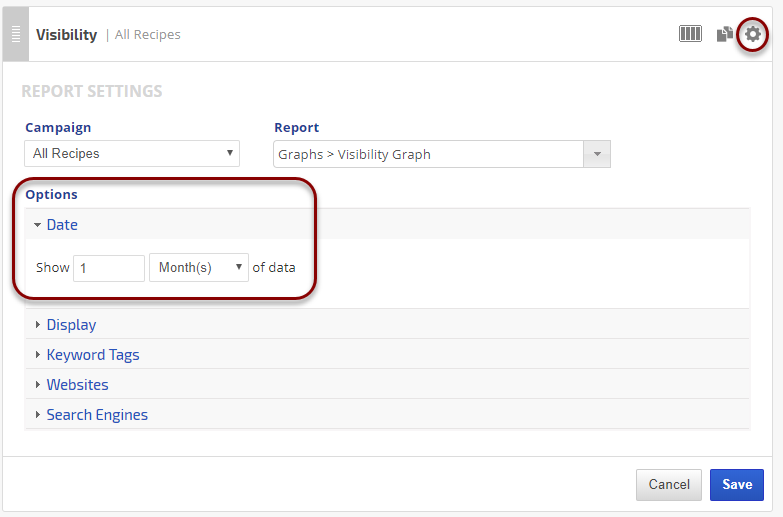The Campaigns Overview is an Enterprise report updated weekly on Mondays for a wide range of metrics in the categories of Rank, Google Analytics, Google Search Console, and Social Analytics, across all campaigns in an account. The User Breakdown widget option is available to display a graph with a combined average rank per selected user. The table will include all campaigns related to the selected user with data per campaign.
This report is intended mainly for your internal use, however, it may be added to a Marketing Dashboard to share with your clients.
- SEO
- Rank Tracker
- Local SEO
- Mobile SEO
- Link Manager
- Landing Pages
- Social Signals
- On-Page Optimization
- Enterprise SEO Solutions
- Marketing
- Competition Analysis
- Insight Graph
- Keyword Research
- Graphs & Widgets
- Market Reach
- Marketing KPI
- Brand Visibility
- White Label SEO
- Marketing Dashboard
- Client Dashboard
- PDF Reports
- PDF Templates
- Other
- Email Notifications
- Portfolio Management
- Integrations
- Google Analytics
- Search Console
- Pay Per Click
- WeDevelop
- API
Documentation
> Organic Search >
Account-Wide Reports
Campaigns Overview
Campaigns Overview Report
Example of Average Rank, Visibility Score & Trend, Rank Position Stats, Traffic, and Social
In addition, the Average Rank Change, Visibility Score Change, and Rank Distribution Change (for each distribution) are available compared to either Last Week/Last Month, depending on the option selected.
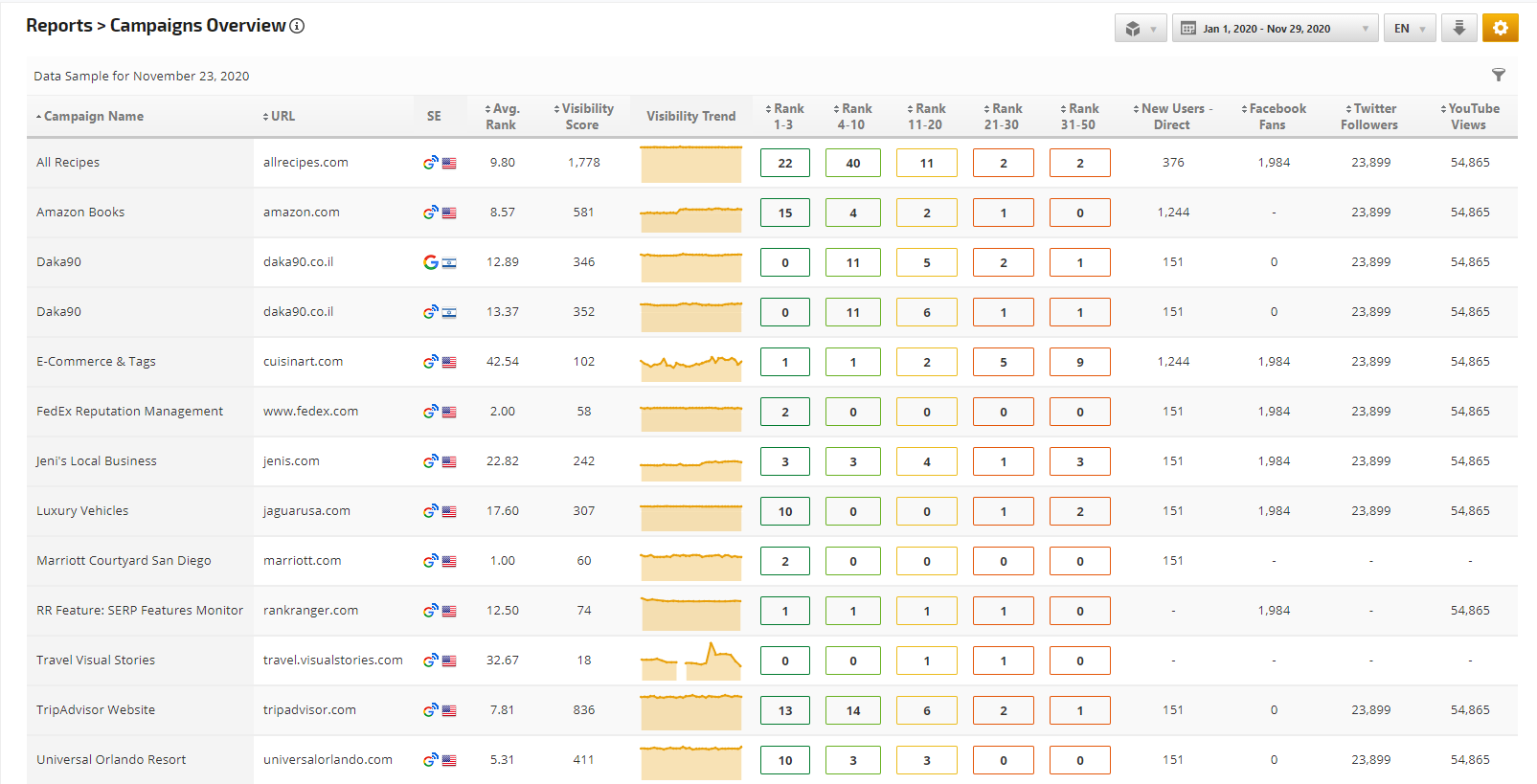
In addition, the Average Rank Change, Visibility Score Change, and Rank Distribution Change (for each distribution) are available compared to either Last Week/Last Month, depending on the option selected.

Mobile Performance Report
Example of Mobile Tracking of Average Rank, Visibility & Rank Positions
In this example, we're displaying the campaign name, search engine, number of keywords, and the following metrics:
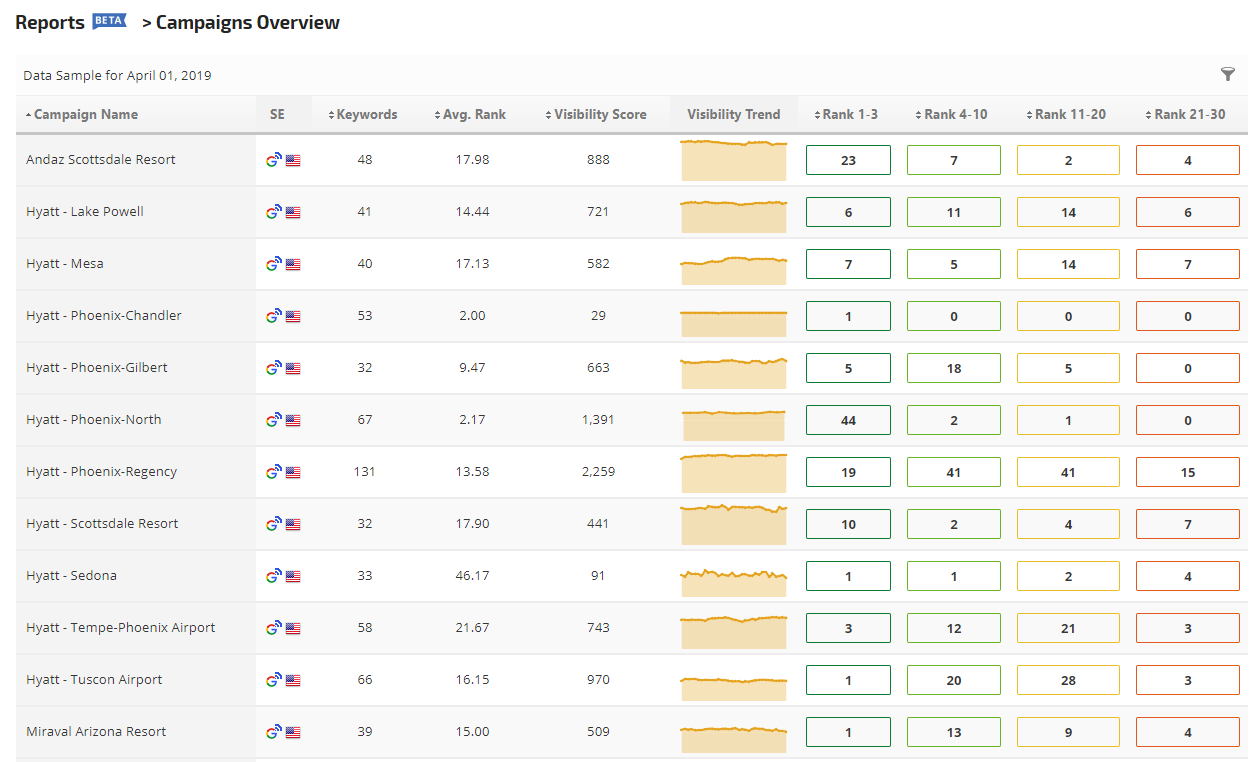
In this example, we're displaying the campaign name, search engine, number of keywords, and the following metrics:
- Average Rank: the average rank of all campaign keywords for 1 day based on the last Monday of the report date range (e.g., if the date range is April 1 - April 30, 2019, then the data will be based on Monday, April 29th).
- Visibility Score: the visibility score for all campaign keywords and selected search engines for 1 day based on the last Monday of the report date range.
- Visibility Trend: a graph of daily visibility scores for a 30-day period ending on the Monday that the data was last updated (i.e., the Monday prior to the last day of the report date range).
- Rank Position Stats: the number of times that campaign keywords ranked in the selected position ranges for all the selected search engines, during the 30 day period ending on the last Monday of the report date range. For example, if 10 keywords ranked in positions 1 through 3 for 30 days on 2 search engines, then that equals 600 rankings in positions 1-3 (10 x 30 x 2).

Traffic Analysis Report
Example of Traffic Analysis: Totals, Organic, Paid, Direct, Referral & Email
All Traffic metrics require that campaigns be integrated with each domain's Google Analytics profile. Google Analytics data in this report is based on the 30-day period leading up to the Monday that the report was updated. Please refer to the Google Search & Ad Metrics Glossary section below for more information regarding the metrics available in this report.
Important! Google sometimes provides sampled data via their API integration depending upon your Google account usage, please refer to their support document on this topic.
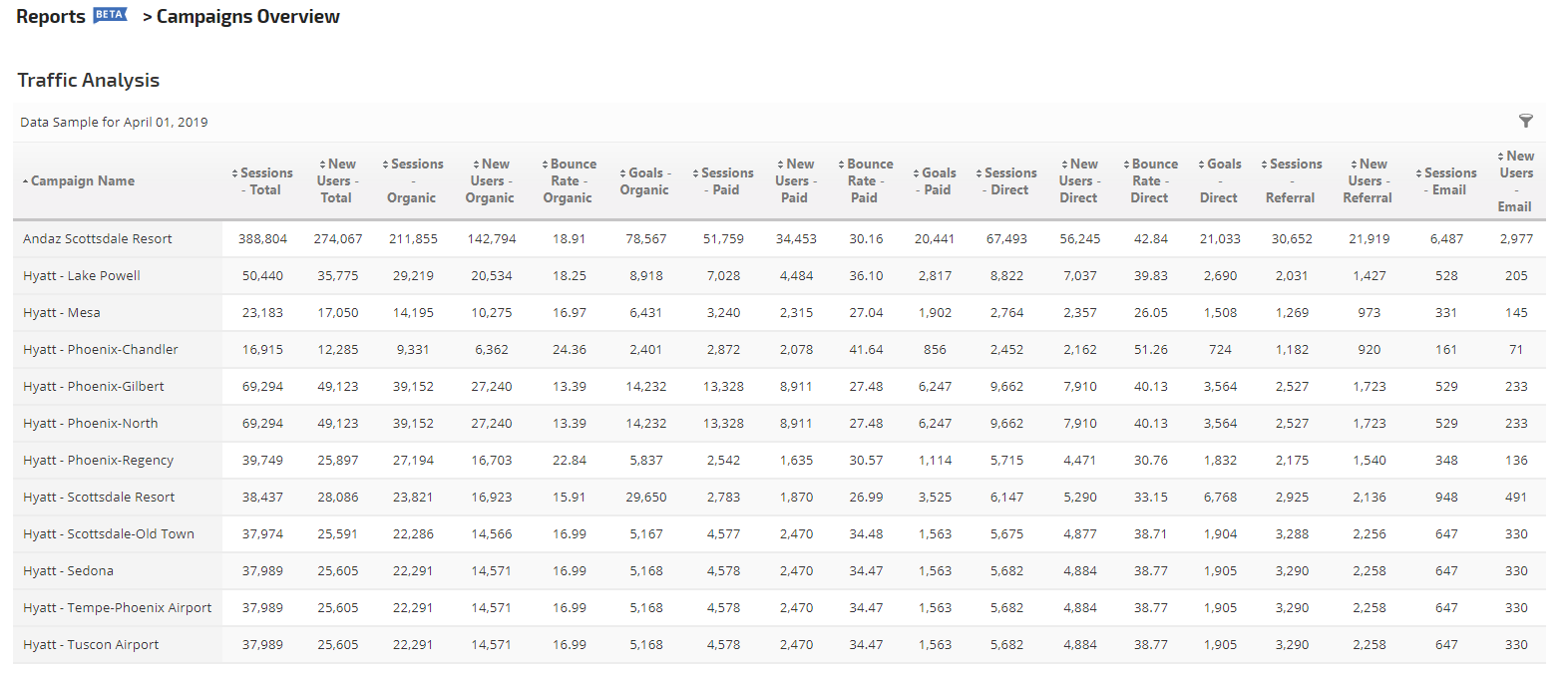
All Traffic metrics require that campaigns be integrated with each domain's Google Analytics profile. Google Analytics data in this report is based on the 30-day period leading up to the Monday that the report was updated. Please refer to the Google Search & Ad Metrics Glossary section below for more information regarding the metrics available in this report.
Important! Google sometimes provides sampled data via their API integration depending upon your Google account usage, please refer to their support document on this topic.

Search & Paid Ad Performance
Example of Metrics from Google Search Console & Ads
Impressions, clicks, CTR, and Average position are based on Search Console API data availability. Google usually makes this data available 3 to 4 days after they collect it (i.e., if you select a report end date of March 31st, it can be April 4th before the data is available via the API). Search Console integration is required for each campaign in order to display data for these metrics.
For Ad data, Google Analytics must be configured correctly (please refer to our Google Analytics documentation) for the primary domain. In addition, Google Ads must be linked to your Google Analytics profile (refer to Link Google Analytics and Ads).
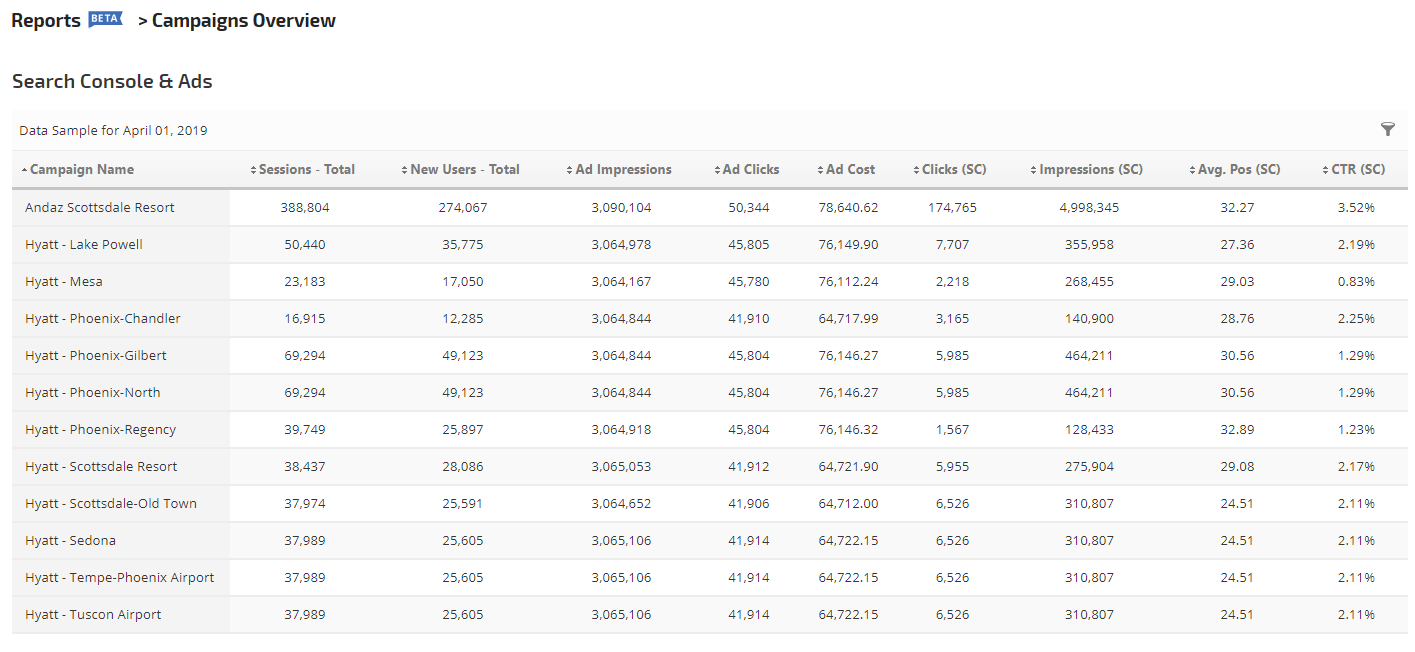
Impressions, clicks, CTR, and Average position are based on Search Console API data availability. Google usually makes this data available 3 to 4 days after they collect it (i.e., if you select a report end date of March 31st, it can be April 4th before the data is available via the API). Search Console integration is required for each campaign in order to display data for these metrics.
For Ad data, Google Analytics must be configured correctly (please refer to our Google Analytics documentation) for the primary domain. In addition, Google Ads must be linked to your Google Analytics profile (refer to Link Google Analytics and Ads).

SERP Features, Average Rank and Visibility
Example of SERP Features Appearances, Average Rank and Visibility Score and Trends
In addition to enabling the display of average rank, visibility score, and visibility trend in Report Options, you may choose to add any of the following SERP Feature appearance metrics to your report:
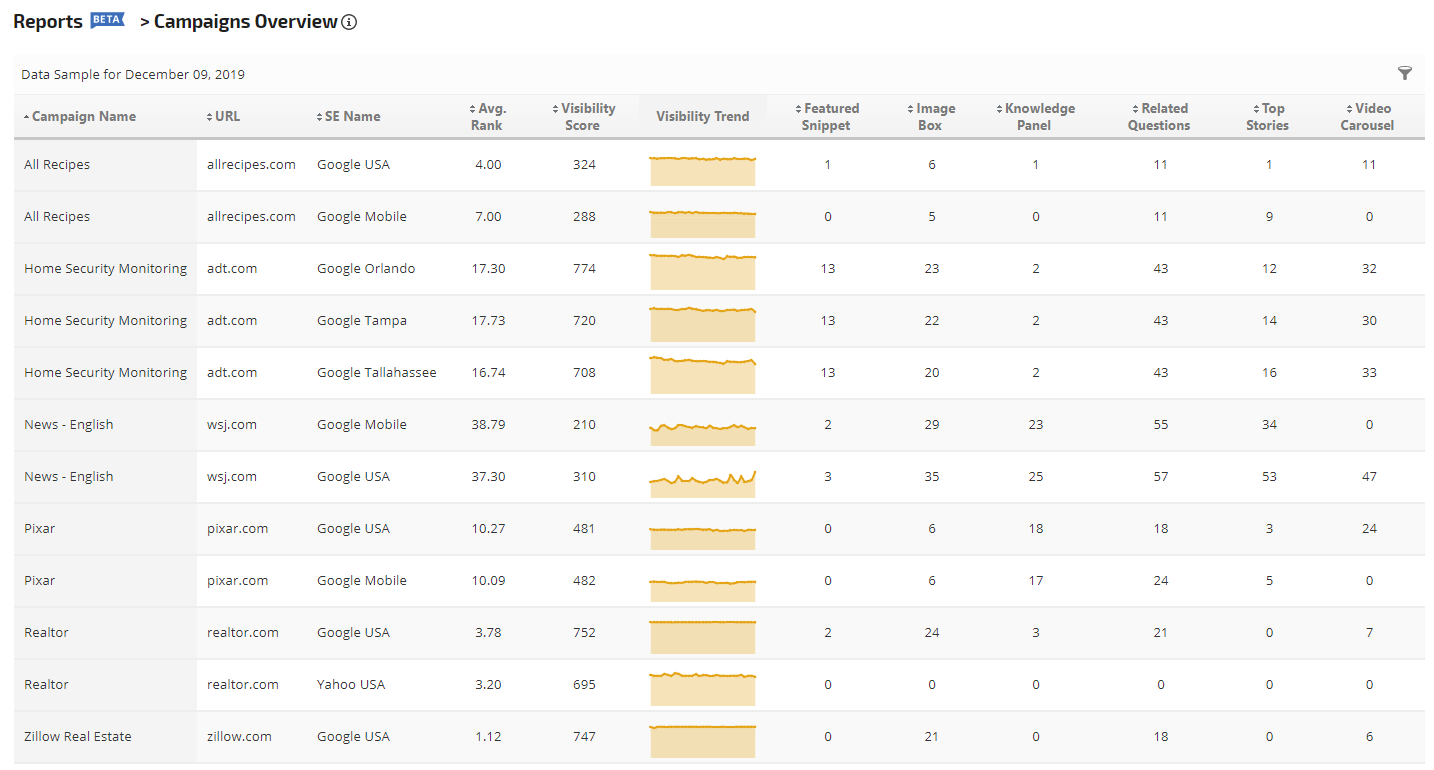
In addition to enabling the display of average rank, visibility score, and visibility trend in Report Options, you may choose to add any of the following SERP Feature appearance metrics to your report:
- Featured Snippet
- Hotel Pack
- Image Box
- Google for Jobs Box
- Knowledge Panel
- Local Pack
- Related Questions
- Top Stories
- Video Carousel

Widgets
User Breakdown Graph
The Campaigns Overview report has the ability to report an average rank grouped by user. To display the User breakdown graph
Only the campaigns assigned to the selected user will be displayed in the table below the graph. The points on the lines in the graph represent the weekly average rank for combined campaigns related to the selected user. One graph line per user.
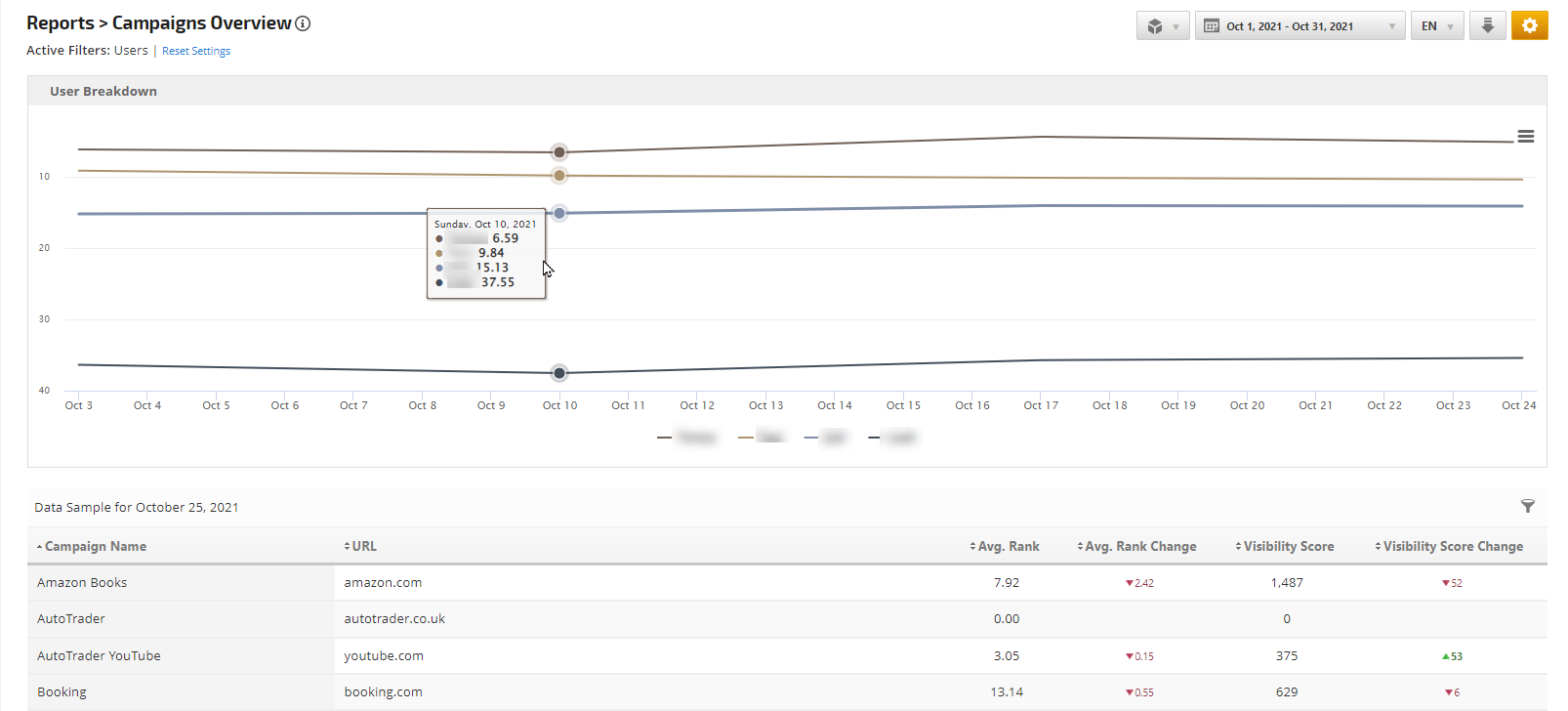
The Campaigns Overview report has the ability to report an average rank grouped by user. To display the User breakdown graph
- Go to Report Options > Widgets and turn on a toggle Enable Widgets
- Then turn on a toggle for Users.
- Select the users from the list in Report Options > Users
- Click Apply Change.
Only the campaigns assigned to the selected user will be displayed in the table below the graph. The points on the lines in the graph represent the weekly average rank for combined campaigns related to the selected user. One graph line per user.

Campaign Breakdown Graph
The Campaigns Overview report has the ability to report an average rank grouped by campaigns.
A line per campaign will be displayed. The points on the lines in the graph represent the weekly average rank for each campaign selected from the Report Options > Campaigns list.

The Campaigns Overview report has the ability to report an average rank grouped by campaigns.
- Go to Report Options > Widgets and turn on a toggle Enable Widgets
- Then turn on a toggle for Campaigns.
- Select the users from the list in Report Options > Campaigns
- Click Apply Change.
A line per campaign will be displayed. The points on the lines in the graph represent the weekly average rank for each campaign selected from the Report Options > Campaigns list.

Accountwide Graph
The Campaigns Overview report has the ability to report an average rank for an entire account including all campaigns.

The Campaigns Overview report has the ability to report an average rank for an entire account including all campaigns.
- Go to Report Options > Widgets and turn on a toggle Enable Widgets
- Then turn on a toggle for Accountwide.
- Click Apply Change.

Report Options
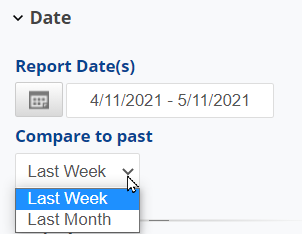 |
Date
|
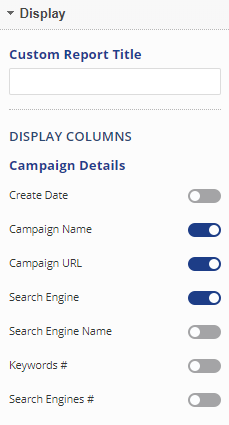 |
Display
Campaign DetailsDisplay or hide the following report columns:
|
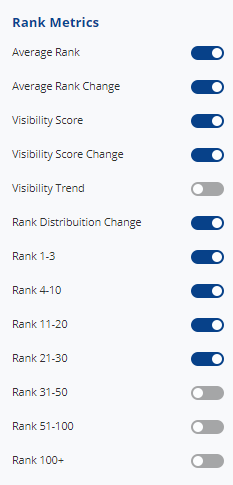 |
Rank Metrics
|
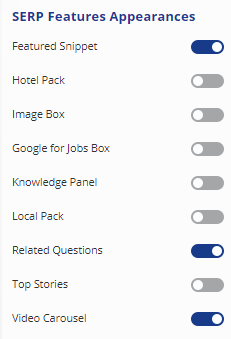 |
SERP Features AppearancesDisplay or hide the following SERP Features Appearances columns to view the total number of times they appeared in search results:
|
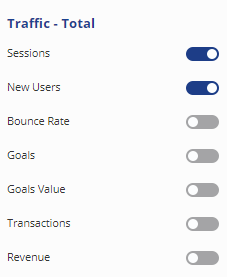 |
Google Analytics Traffic - TotalAll Traffic metrics require that campaigns be integrated with each domain's Google Analytics profile. Google Analytics data in this report is based on the 30-day period leading up to the Monday that the report was updated. Please refer to the Google Search & Ad Metrics Glossary section below for more information regarding the metrics available in this report. Important! Google sometimes provides sampled data via their API integration depending upon your Google account usage, please refer to their support document on this topic. Display or hide the following total traffic report columns:
|
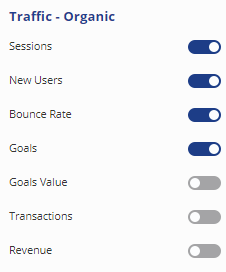 |
Traffic - OrganicDisplay or hide the following organic traffic report columns:
|
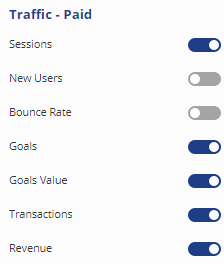 |
Traffic - PaidDisplay or hide the following paid traffic report columns:
|
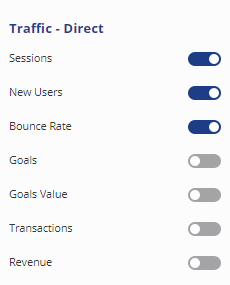 |
Traffic - DirectShow or hide the following direct traffic report columns:
|
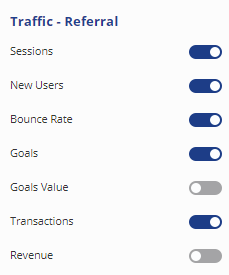 |
Traffic - ReferralDisplay or hide the following referral traffic report columns:
|
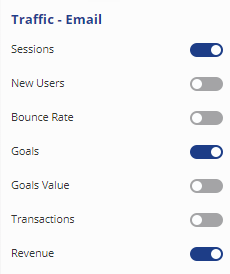 |
Traffic - EmailDisplay or hide the following email traffic report columns:
|
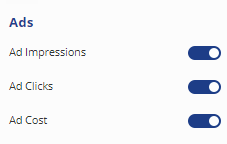 |
AdsFor Ad data, Google Analytics must be configured correctly (please refer to our Google Analytics documentation) for the primary domain. In addition, Google Ads must be linked to your Google Analytics profile (refer to Link Google Analytics and Ads). Display or hide the following Google Ads report columns:
|
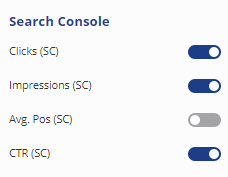 |
Search ConsoleThis section of the report is based on Search Console API data availability. Google usually makes this data available 3 to 4 days after they collect it (i.e., if you select a report end date of March 31st, it can be April 4th before the data is available via the API). Search Console integration is required for each campaign in order to display data for these metrics. |
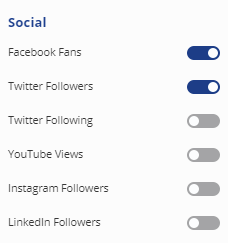 |
SocialIntegration with Facebook, Twitter, YouTube, Instagram, and/or LinkedIn analytics is required in order for social data to be available in this report. Display or hide the following social analytics report columns:
|
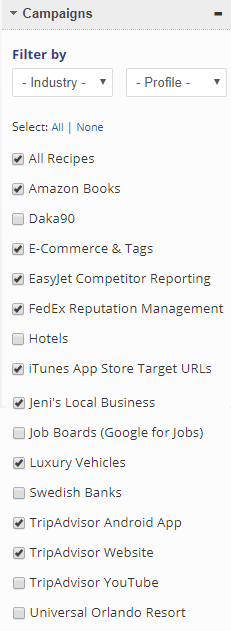 |
CampaignsSelect the campaigns that you want to be included in this report using one of these methods:
|
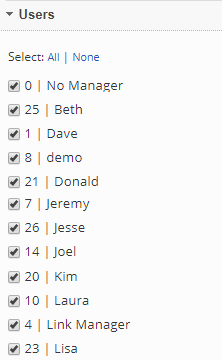 |
Users
|
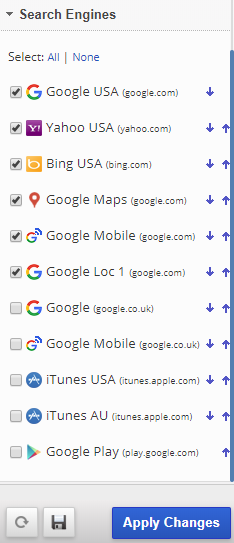 |
Search Engines
|
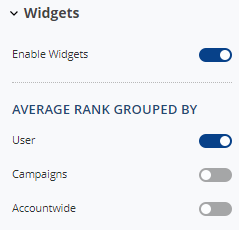 |
Widgets
|
Add to PDF Report
Conveniently add a report or graph with its current settings to a PDF report by hovering over the gold gear icon and selecting Add to PDF Reports
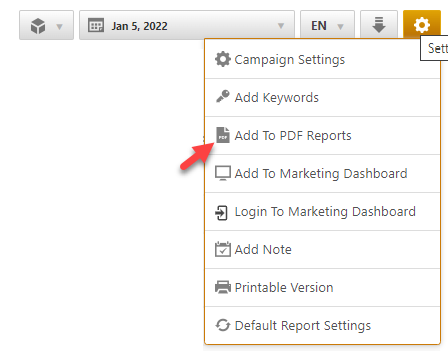

Select the PDF Report that you want the report or graph added to
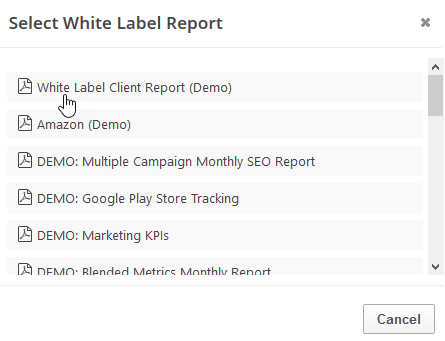
Drag the new report or graph into the position you want it to display in the PDF and confirm that the Date settings do not conflict with the automated scheduling settings.
Add to Marketing Dashboard
Conveniently add a report or graph with its current settings to a marketing dashboard:
1. Hover over the gold gear icon and select Add to Marketing Dashboard
2. Select the Dashboard (campaign name)
3. Select the Dashboard Page that you want the report added to
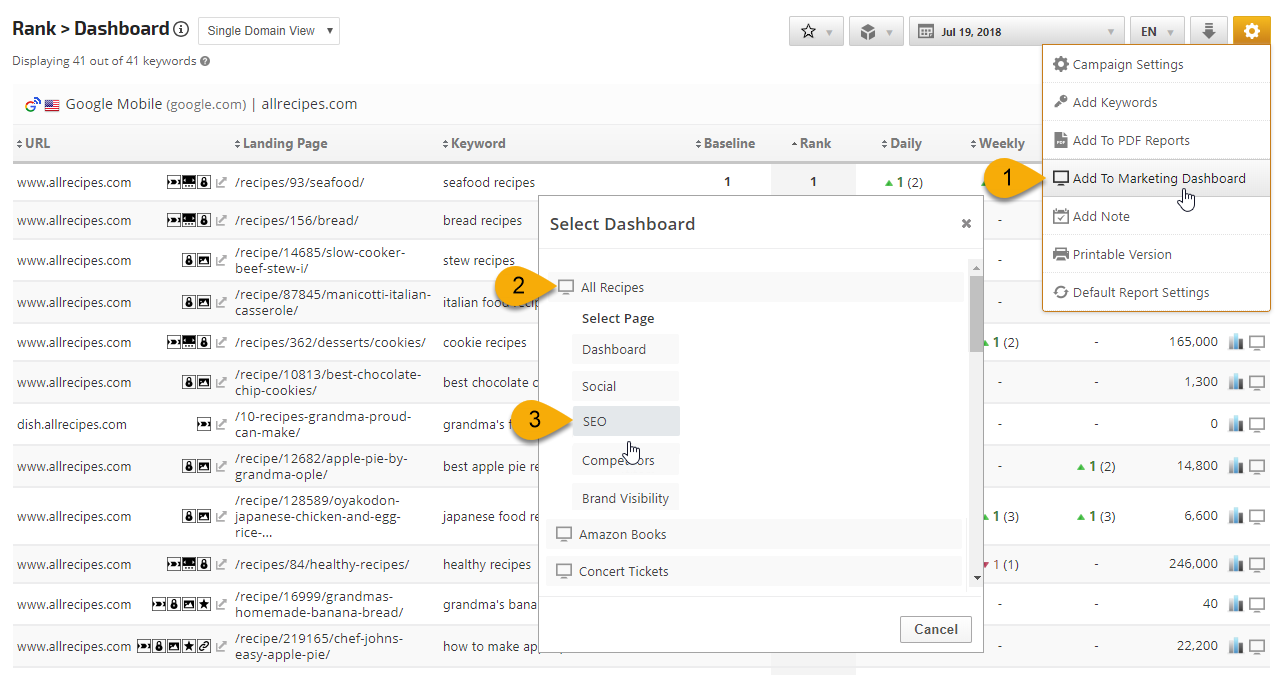
1. Hover over the gold gear icon and select Add to Marketing Dashboard
2. Select the Dashboard (campaign name)
3. Select the Dashboard Page that you want the report added to

4. Click the "Go to Dashboard" link to further customize the report (e.g., drag it to a specific position on the page, change date settings, etc.)
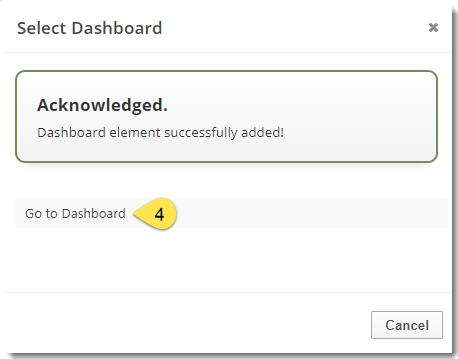
Refer to the Report Options section for details regarding the display settings, filters and sort options available for this report.
The report date (or date range) is governed by the selected Dashboard date option: Date Selection or Fixed Periods, learn more...
- Daily reports default to the last day of the selected period
- Weekly and monthly reports default to 1 month of data
Enterprise Account Features
Designed for marketing professionals who manage major brands or large numbers of clients, Rank Ranger Enterprise provides scalable access for teams, ensuring that everyone has the tools they need to be successful.
In addition to our standard plan features, Enterprise plans include:
- Campaign Archive allows storage of campaign settings and history for future reference, and ability to reactivate campaigns when needed, for efficient management of account resources.
- Portfolio Management Reporting (multiple campaigns)
- Brand Visibility Management Report
- Geo Insights Mapping Report (multiple campaigns)
- Campaigns Overview Report (multiple campaigns)
- Cross Campaigns Report (multiple campaigns)
- Cross Campaign Keyword Report (multiple campaigns)
- Daily Snapshot by Tag Report
- Monthly Average Weighted Snapshot by Tag Report
- Quarterly Rank Snapshot Report
- Insight Graph SERP Features for Google Desktop and Mobile, plus Cross Campaign and Custom View metrics
- Platform access for multiple team members with individual user permission settings (additional users option available)
- User Activity Log for tracking individual user's actions (e.g., adding keywords, deleting campaigns, etc.)
- Account Management/Data and Rank Reporting Developer APIs
- Premium third party data integrations
- Dedicated Account Manager
- WeDevelop & Beta program participation
- Special billing and payment options (upon request)
- VIP capacity monitoring and upgrade option (based on service level agreement)
Google Search & Ad Metrics Glossary
The below-listed metrics are only for the Google Analytics Universal Profile connection.
Wondering what some of the Google metrics in our reports and graphs mean?
| Ad Clicks | Displays the number of times viewers of a banner click on an ad to view the full offer. |
| All Users | Total of new users and returning users for a given period of time. |
| Assisted Conversions | Google's measure of any interaction, other than the final click, that led to a consumer converting on a website. |
| Assisted Value | The total value of the conversions assisted by the channel. |
| Attribution | The process of assigning credit for sales and conversions to touchpoints in conversion paths. Attribution allows marketers to quantify each channel's contribution to sales and conversions. For example, many people may purchase on your site after searching for your brand on Google. Refer to this Google Support document for more information. |
| Avg. Time on Site | Displays the average length of time a visitor spent on a particular page or set of pages. |
| Avg. Value | A calculation of Event Value / Total Events. |
| Bounce Rate | Displays the percentage of single-page visits (i.e. visits in which the person left your site from the page they entered through without going deeper inside your site). |
| Completions | The total number of users who have completed all elements defined for a particular goal. |
| Conversion | A completed activity, online or offline, that is important to the success of your business. Examples include a completed sign-up for your email newsletter (a Goal conversion) and a purchase (a transaction, sometimes called an Ecommerce conversion). Refer to this Google Support document for more information. |
| Conversion Rate | The number of conversions is divided by the number of total ad clicks that can be tracked to a conversion during the same time period. |
| Cost | The total cost of Google AdWords campaigns, in currency units defined by the Google account user. |
| Channel Grouping | A roll-up of traffic sources in the Acquisition reports that groups several marketing activities together. Channel groupings allow you to view and compare aggregated metrics by channel name, as well as an individual traffic source, medium, or campaign name. Refer to this Google Support document for more information. |
| CPC (Cost Per Click) | Cost-per-click is the average cost an advertiser paid for each click on search ad(s). |
| CTR (Click Through Ratio) | Displays the Click-through-ratio for an ad. This is equal to the number of clicks divided by the number of impressions the ad received. |
| Dimension | A descriptive attribute or characteristic of an object that can be given different values. For example, a geographic location could have dimensions called Latitude, Longitude, or City Name. Values for the City Name dimension could be New York, London, etc. Refer to this Google Support document for more information. |
| Event | A type of hit used to track user interactions with content. Examples of user interactions commonly tracked with Events include downloads, mobile ad clicks, gadgets, Flash elements, AJAX embedded elements, and video plays. Refer to this Google Support document for more information. |
| Event Value | A calculation of Total Event * Value. |
| Exit Rate | How often do users end their session or leave the site after viewing a particular page |
| Goal | A configuration setting that allows you to track the valuable actions, or conversions, that happens on a site or mobile app. Goals allow you to measure how well your site or app fulfills your target objectives. Refer to this Google Support document for more information. |
| Hits | An interaction that results in data being sent to Analytics. Common hit types include page tracking hits, event tracking hits, and e-commerce hits. Each time the tracking code is triggered by a user’s behavior (for example, the user loads a page on a website or a screen in a mobile app), Analytics records that activity. Each interaction is packaged into a hit and sent to Google’s servers. Refer to this Google Support document for more information. |
| Impressions (Ads) | The measurement of how many times an ad is shown. |
| Impressions (Search Console) | An impression is the display of a website link in search results or an advertisement. This metric accounts for the total number of impressions recorded by Google for a website or ad campaign. |
| Last Interaction Conversions | The ratio of assisted/last interaction conversions. This is a number that indicates whether this channel primarily results in last interaction conversions or is predominantly assisted conversions. Numbers of 1.5 and higher indicate that this channel is predominantly accounting for assisted conversions, while numbers closer to 0 indicate the channel’s contribution to conversions is predominantly as the last interaction. |
| Last Interaction Value | The total value of the conversions completed by the listed channels. |
| Metric | Individual elements of a dimension that can be measured as a sum or a ratio. For example, the dimension City can be associated with a metric like Population, which would have a sum value of all the residents of the specific city. Refer to this Google Support document for more information. |
| New Users | New Users is based on Google's ga:newUsers metric and represents the number of sessions marked as a user's first sessions. |
| New Users % | New Users % is based on Google's ga:percentNewSessions metric that represents the percentage of sessions by users who had never visited the site before. It does not represent the number of new users between one period and the previous. In this Google Developer document, it is described as the calculation of ga:newSessions / ga:sessions |
| New Visits | Displays the number of new visits by people who have never been to the site before. |
| Organic Traffic | Number of users who find your website ‘organically’ through search results, as opposed to via a paid ad, clicking a link on another site, or from a bookmark they already have saved. |
| Paid Traffic | Number of visitors to your site who came there via Google Ads, paid search keywords and other online ad campaigns. |
| Pageviews | An instance of a page being loaded (or reloaded) in a browser. Pageviews is a metric defined as the total number of pages viewed. Refer to this Google Support document for more information. |
| Permission | The right to perform administrative and configuration tasks, to create and share assets, and to read and interact with report data. Refer to this Google Support document for more information. |
| Property | A sub-component of an Analytics account that determines which data is organized and stored together. Refer to this Google Support document for more information. |
| Revenue | Specifies the total revenue or grand total associated with the transaction (e.g. 11.99). This value may include shipping, tax costs, or other adjustments to total revenue that you want to include as part of your revenue calculations. |
| Roll-Up Reporting | A feature of Roll-Up Properties, which aggregate data from multiple source properties into a single property. Refer to this Google Support document for more information. |
| Sampling | The practice of selecting a subset of data from your traffic and reporting on the trends detected in that sample set. Refer to this Google Support document for more information. |
| Segment | A subset of sessions or users that share common attributes. Segments allow you to isolate and analyze groups of sessions or users for better analysis. Refer to this Google Support document for more information. |
| Session | The period of time a user is active on your site or app. By default, if a user is inactive for 30 minutes or more, any future activity is attributed to a new session. Refer to this Google Support document for more information. |
| Sessions with Event | The number of sessions during which an Event was recorded. |
| Source / Medium | Source: the origin of your traffic, such as a search engine (for example, google) or a domain (example.com). Medium: the general category of the source, for example, organic search (organic), cost-per-click paid search (cpc), web referral (referral). Refer to this Google Support document for more information. |
| Tags | Referring to Google Tag Manager, a Tag is a snippet of JavaScript that sends information to a third party, such as Google. The Analytics tracking code is an example of a tag. Refer to this Google Support document for more information. |
| Total Events | A total of Events (executions of a specific action) that occurred on a website during a specified period of time. |
| Unique Events | The number of unique events that occurred on a website during a specific period of time. |
| Unique Page Views | The number of times a page was viewed during a specific time period. |
| Views | The number to views a website or specific web page received during a report period. |
| Visits By Medium | Displays the number of visits by medium through which your site was reached. For example, every referral to a website also has a medium. Possible mediums include: "organic” (unpaid search), "cpc” (cost per click, i.e. paid search), "referral” (referral), "email” (the name of a custom medium you have created), "none” (direct traffic has a medium of "none”). |
| Visits By Source | Displays the number of visits by source that brought visitors to your website. For example, every referral to a web site has an origin, or source. Possible sources include: "google” (the name of a search engine), "facebook.com” (the name of a referring site), "spring_newsletter” (the name of one of your newsletters), and "direct” (users that typed your URL directly into their browser, or who had bookmarked your site). |
We will update this periodically, but in the meantime if there are metrics you're curious about that aren't listed in this glossary, please refer to this Google support document.

